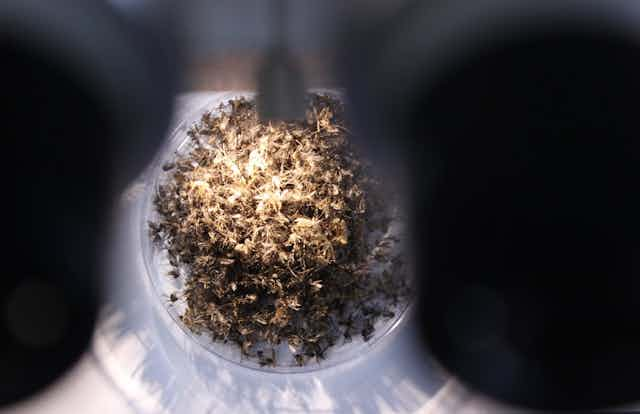This is the worst year for mosquitoes ever!
I hear this every year. I know it’s not true. We’re quick to forget those swarms from last summer as the chill of winter wipes our memory.
Sometimes, however, it is actually true. This Australian spring has been plagued by unseasonably large mosquito populations. There have also been warnings from health authorities about elevated risks of mosquito-borne diseases. But how do scientists catch, count and analyse the changes in mosquito populations from year to year?
More than one mosquito
While it is true the only mosquito most people care about is the one buzzing around their ears at night, or biting their ankles at the backyard barbecue, there are hundreds of different species of mosquito in Australia. They’re just as much a part of the Australian environment as any other wildlife.
One thing that makes mosquitoes so fascinating to study is they have two distinct parts to their life cycle. In one half, they’re flying about, biting and laying eggs; in the other half, they’re confined to the water where they undergo four developmental stages, including as “wrigglers”, and “pupae” from which the adult mosquito emerges.
Although these immature stages all need water, the types of water they’re found in varies from polluted puddles to pristine mountain streams and from mangrove forests to pot plant saucers.
Each mosquito has a preference for where it lays eggs so changes in the populations of these mosquitoes will be determined by the different ways each habitat fills with water. Is it through rainfall, high tides, melting snow or by turning on the hose to fill a bucket with water on a hot summer’s day?

How do you catch and count mosquitoes?
There are lots of different ways to catch a mosquito. Head out into the backyard in the late afternoon and it won’t be long until a mosquito comes looking for blood. While using “human bait” may have its place in some circumstances, it’s not the way surveillance for mosquitoes and mosquito-borne pathogens is undertaken in Australia.
At the heart of mosquito surveillance is a humble mosquito trap. They’re low tech but incredibly effective. To the passerby, they look like a paint tin and ice cream bucket hanging from a tree, but to a mosquito, they can be irresistible.
The traps use carbon dioxide (often provided by dry ice or gas cyclinder) to attract female mosquitoes looking for a blood meal. For mosquitoes looking for blood, the plume of carbon dioxide drifting from the trap is like a breadcrumb trail; they follow it expecting a blood meal from a bird, cow or kangaroo (all of which exhale carbon dioxide). Unfortunately for them, they’ll end up being sucked into the trap and transported back to a laboratory where they’ll be killed and counted.
We typically set these traps once a week. We hang them in a tree near wetlands or bushland in the late afternoon and collected them the following morning. This routine continues in many parts of Australia during spring, summer and autumn.
The mosquitoes caught provide a multitude of insights to guide the responses of local health authorities.
First, the abundance and diversity of mosquitoes provides an indication of the likely pest and public health risks. Greater numbers of mosquitoes that bite people and, worse still, transmit viruses that can make us sick, will raise the risk to public health. More mosquitoes bite more people. While nuisance-biting increases, more mosquitoes doesn’t always mean more disease.
For the most common mosquito-borne disease in Australia, Ross River virus, there is a complex relationship between mosquitoes, wetlands, wildlife and the viral pathogen itself. Mosquitoes don’t emerge from wetlands infected with the virus; they must pick it up from biting native wildlife, most commonly kangaroos and wallabies. This makes predicting outbreaks of disease difficult.
Fortunately, those trapped mosquitoes can give an early warning of disease risk. We can test mosquitoes to see if they carry pathogens. This information is then passed back to local health authorities, which may decide to issue public health warnings or, in some cases, to control mosquitoes. These decisions depend on the abundance and diversity of mosquitoes, the activity of viruses and prevailing climatic conditions.
Why do mosquito numbers fluctuate?
This data also comes in handy when we look back at outbreaks of disease to work out how and why they happened. We can compare the information gathered from mosquitoes to the official statistics on human disease. This then helps develop predictive models of mosquito-borne disease or may help track changes in mosquitoes and health risks associated with a changing climate.
While it is true more water flooding wetlands often results in more mosquitoes, when and where the water comes from can make all the difference.
It doesn’t matter how much water is about, if it is during the winter, or conditions are unseasonably cool, you’ll rarely see a boost in mosquito numbers. More than water, mosquitoes need warmth.
Some of our coastal mosquitoes, which rely on tides to flood salt marshes and mangrove forests, prefer dry conditions. This is because during periods of above average rainfall, pools and ponds in the wetlands become suitable for fish and other mosquito predators, helping keep numbers down. It seems counter-intuitive but these mosquitoes love a hot and dry summer.
Most importantly, the data from mosquito trapping can help answer the question “Is this the worst year for mosquitoes ever?!” More often than not, the answer is no. Worryingly, for some parts of Australia this summer, the answer may be yes.

